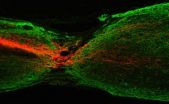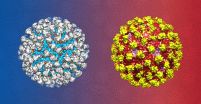Rapid response to kids' stroke symptoms may speed diagnosis
American Heart Association Rapid Access Journal Report
2015-07-02
(Press-News.org) DALLAS, July 2, 2015 -- An emergency room rapid response plan for children can help diagnose stroke symptoms quickly, according to new research in the American Heart Association journal Stroke.
"Just as there are rapid response processes for adults with a possible stroke, there should be a rapid response process for children with a possible stroke that includes expedited evaluation and imaging or rapid transfer to a medical center with pediatric stroke expertise," said Lori Jordan, M.D., Ph.D., study senior author and an assistant professor of pediatrics and neurology at Monroe Carell Jr. Children's Hospital at Vanderbilt in Nashville, Tennessee. "We need the emergency department, radiology, critical care medicine and often many other specialists to work quickly and efficiently together to treat pediatric patients."
Researchers reviewed quality improvement data from Vanderbilt's pediatric stroke program. They established a "stroke alert" plan in the emergency room which requires a neurology resident to see a child with stroke symptoms within 15 minutes and for most children, quickly obtain an MRI.
Using the method for 124 children (average age 11) with stroke-like symptoms between April 2011 and October 2014, researchers found:
24 percent suffered strokes and 2 percent had transient ischemic attacks (TIA);
17 percent had complex migraine (associated with neurological symptoms),
15 percent suffered seizures, and
14 percent were diagnosed with critical illnesses such as meningitis, encephalitis or tumors.
Of the confirmed stroke/TIA patients, 13 percent had sickle cell anemia or congenital heart disease.
The most common presenting symptoms were weakness (65 percent), altered mental status (44 percent) and headache (37 percent).
The median time between emergency department arrival and neurology consultation was 28 minutes, and the median time from consultation to neurologist at-bedside was 7 minutes researchers said. About 94 minutes elapsed between emergency department arrival to MRI and 59 minutes between arrival and CT.
"Rapid evaluation and appropriate testing is critical," said Jordan, who also is director of the Vanderbilt Pediatric Stroke Program. "Prior studies have suggested that stroke in children often takes a long time to diagnose due to delays in imaging. In one recent Canadian study, in-hospital delay was 12.7 hours for children with stroke. We were able to initiate the most accurate type of brain scan, a MRI of the brain, within 94 minutes on average."
"Know the symptoms of stroke and consider the possibility of a stroke no matter what a person's age and have your child rapidly evaluated."
INFORMATION:
Co-authors are Travis Ladner, B.A.; Jasia Mahdi, M.D.; Melissa Gindville, M.S.; Angela Gordon, R.N.; Z. Leah Harris, M.D.; Kristen Crossman, M.D.; Sumit Pruthi, M.B.B.S.; and Thomas Abramo, M.D. Author disclosures and funding are on the manuscript.
Additional Resources:
Researcher photo and stroke illustrations are available on the right column of the release link http://newsroom.heart.org/news/rapid-response-to-kids-stroke-symptoms-may-speed-diagnosis?preview=c152ddb42d8b0d846a0ef6f31ff16a6d
Pediatric Stroke
Stroke Warning Signs
Follow AHA/ASA news on Twitter @HeartNews.
For stroke science, follow Stroke at @StrokeAHA_ASA.
Statements and conclusions of study authors published in American Heart Association scientific journals are solely those of the study authors and do not necessarily reflect the association's policy or position. The association makes no representation or guarantee as to their accuracy or reliability. The association receives funding primarily from individuals; foundations and corporations (including pharmaceutical, device manufacturers and other companies) also make donations and fund specific association programs and events. The association has strict policies to prevent these relationships from influencing the science content. Revenues from pharmaceutical and device corporations are available at http://www.heart.org/corporatefunding.
ELSE PRESS RELEASES FROM THIS DATE:
2015-07-02
Researchers at the Hong Kong University of Science and Technology (HKUST) have found a way to stimulate the growth of axons, which may spell the dawn of a new beginning on chronic SCI treatments.
Chronic spinal cord injury (SCI) is a formidable hurdle that prevents a large number of injured axons from crossing the lesion, particularly the corticospinal tract (CST). Patients inflicted with SCI would often suffer a loss of mobility, paralysis, and interferes with activities of daily life dramatically. While physical therapy and rehabilitation would help the patients to ...
2015-07-02
Washington, D.C. - July 2, 2015 - Male fruit flies infected with the bacterium, Wolbachia, are less aggressive than those not infected, according to research published in the July Applied and Environmental Microbiology, a journal of the American Society for Microbiology. This is the first time bacteria have been shown to influence aggression, said corresponding author Jeremy C. Brownlie, PhD, Deputy Head, School of Natural Sciences, Griffith University, Brisbane, Australia.
The research began with a discovery by University of Arizona student Elizabeth Bondy, an undergraduate ...
2015-07-02
Astronomers are gearing up for high-energy fireworks coming in early 2018, when a stellar remnant the size of a city meets one of the brightest stars in our galaxy. The cosmic light show will occur when a pulsar discovered by NASA's Fermi Gamma-ray Space Telescope swings by its companion star. Scientists plan a global campaign to watch the event from radio wavelengths to the highest-energy gamma rays detectable.
The pulsar, known as J2032+4127 (J2032 for short), is the crushed core of a massive star that exploded as a supernova. It is a magnetized ball about 12 miles ...
2015-07-02
MINNEAPOLIS - A new study suggests that genes may not be to blame for the increased risk of heart disease some studies have shown in people with migraine, especially those with migraine with aura. The research is published during Headache/Migraine Awareness Month in the inaugural issue of the journal Neurology® Genetics, an open access, or free to the public, online-only, peer-reviewed journal from the American Academy of Neurology. Aura are sensations that come before the headache, often visual disturbances such as flashing lights.
"Surprisingly, when we looked ...
2015-07-02
BOSTON -- A new study led by scientists at Beth Israel Deaconess Medical Center (BIDMC) shows that an HIV-1 vaccine regimen, involving a viral vector boosted with a purified envelope protein, provided complete protection in half of the vaccinated non-human primates (NHPs) against a series of six repeated challenges with simian immunodeficiency virus (SIV), a virus similar to HIV that infects NHPs. These findings are published online today in Science.
Based on these pre-clinical data, the HIV-1 version of this vaccine regimen is now being evaluated in an ongoing Phase ...
2015-07-02
One more piece and we are done! A research team led by the Duke-NUS Graduate Medical School Singapore (Duke-NUS) has found the second-to-last piece of the puzzle needed to potentially cure or treat dengue. This is welcome news as the dengue virus infects about 400 million people worldwide annually, and there is currently no licensed vaccine available to treat it.
Associate Professor Shee-Mei Lok and Research Fellow Guntur Fibriansah, from the Duke-NUS Emerging Infectious Diseases (EID) Programme, led research that showed how an antibody neutralises dengue virus serotype ...
2015-07-02
In a new Science study, Duke-NUS Graduate Medical School Singapore (Duke-NUS) scientists have identified how small changes in dengue's viral genome can affect the virus' ability to manipulate human immune defences and spread more efficiently. This research is the first of its kind that examined the dengue virus starting from broad population level observations and then linked it to specific molecular interactions, to explain an outbreak. This work provides a framework for identifying genomic differences within the virus that are important for epidemic spread.
Dengue virus ...
2015-07-02
This news release is available in Japanese. Detailed tabletop experiments are helping researchers understand how Earth's landscapes erode to form networks of hills and valleys. The findings, which highlight a balance between processes that send sediments down hills and those that wash them out of valleys, might also help researchers predict how climate change could transform landscapes in the future. Kristin Sweeney and colleagues developed a laboratory device that mimicked the processes that smooth or disturb soil to make hillslopes, and those that cut it away to make ...
2015-07-02
This news release is available in Japanese. Researchers have discovered that a human antibody specific to dengue virus serotype 2, called 2D22, protects mice from a lethal form of the virus -- and they suggest that the site where 2D22 binds to the virus could represent a potential vaccine target. The mosquito-borne virus, which infects nearly 400 million people around the world each year, has four distinct serotypes, or variations, and there is currently no protective vaccine available. Recent phase 3 clinical trials of a potential vaccine candidate showed poor efficacy, ...
2015-07-02
Why is the seahorse's tail square? An international team of researchers has found the answer and it could lead to building better robots and medical devices. In a nutshell, a tail made of square, overlapping segments makes for better armor than a cylindrical tail. It's also better at gripping and grasping. Researchers describe their findings in the July 3 issue of Science.
"Almost all animal tails have circular or oval cross-sections--but not the seahorse's. We wondered why," said Michael Porter, an assistant professor in mechanical engineering at Clemson University and ...
LAST 30 PRESS RELEASES:
[Press-News.org] Rapid response to kids' stroke symptoms may speed diagnosis
American Heart Association Rapid Access Journal Report



